
Grias is a genus of flowering plants in the family Lecythidaceae, described by Linnaeus in 1759. It is native to northwestern South America, Central America, and Jamaica.
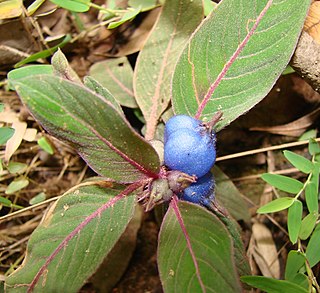
Coccocypselum is a genus of flowering plants in the family Rubiaceae. It is native to Mexico, Central America, the West Indies and South America. All species of the genus Coccocypselum are herbaceous with fleshy, blue or purple fruits, and 4-petaled flowers.

Sideroxylon is a genus of trees in the family Sapotaceae described as a genus by Linnaeus in 1753. They are collectively known as bully trees. The generic name is derived from the Greek words σιδηρος (sideros), meaning "iron", and ξύλον (xylon), meaning "wood."
Chamguava is a genus of the botanical family Myrtaceae, first described as a genus in 1991. It is native to southern Mexico and Central America.
- Chamguava gentlei(Lundell) Landrum - Chiapas, Belize, Guatemala, Honduras
- Chamguava musarum(Standl. & Steyerm.) Landrum - Guatemala
- Chamguava schippii(Standl.) Landrum - Guerrero, Chiapas, Belize, Guatemala, Panama

Aegiphila is a genus of flowering plants in the mint family, Lamiaceae, first described in 1763. It was formerly classified in the Verbenaceae. It is native to Mexico, Central America, South America, the West Indies, and Florida.

Brunellia is a genus of trees. They are distributed in the mountainous regions of southern Mexico, Central America, West Indies, and South America. Brunellia is the only genus in the family Brunelliaceae. As of 2001 there were about 54 species.

Renealmia is a plant genus in the family Zingiberaceae. Its members are native to tropical Africa and tropical America. In Peru, fruits and tubers are sources of indigenous dyes. and indigenous medical treatments for leishmania and malaria In Colombia, it is used to treat snakebite. Bracts and leaves can serve as phytotelmata, retaining small quantities of water that offer habitat for other organisms.

Callisia is a genus of flowering plants in the spiderwort family, Commelinaceae. Members of the genus are commonly known as roselings. It is native to the Western Hemisphere from the southern United States to Argentina. The generic name is derived from the Greek word κάλλος (kallos), meaning "beauty."
Wamalchitamia is a genus of Mesoamerican flowering plants in the family Asteraceae.

Chiococca is a genus of flowering plants in the family Rubiaceae. It currently holds 23 species that are native to Florida, Texas, Mexico, Central America, much of South America, the West Indies, and the islands of Galápagos and Fernando de Noronha.

Gibasis is a genus of flowering plants within the Commelinaceae family, first described in 1837. It is native to the Western Hemisphere from Texas and the West Indies south to Argentina, with most of the species native to Mexico.

Crusea is a genus of angiosperms in the family Rubiaceae. The genus is found in the south-western United States, Mexico, and Central America. A few species are naturalized in Cuba and Puerto Rico.

Chomelia is a genus of flowering plants in the family Rubiaceae. It is native to Mexico, Central America, the West Indies, and much of South America as far south as Argentina.

Tinantia anomala, common name false dayflower or widow's-tears, is a plant species in the Commelinaceae, related to the Mexican wandering Jew, Tinantia pringlei. It is known only from Texas except for a single specimen from the Mexican state of Durango. It is found on rocky slopes, ravines, the edges of woodlands etc.
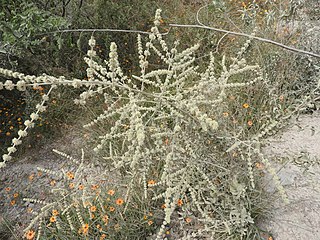
Asterohyptis is a genus of plants in the Lamiaceae, or mint family, first described in 1932. It is native to Mexico and Central America.
- Asterohyptis mocinoana(Benth.) Epling - widespread from Veracruz to Costa Rica
- Asterohyptis nayaranaB.L.Turner - Durango, Nayarit
- Asterohyptis seemannii(A.Gray) Epling - Chihuahua, Sonora, Sinaloa
- Asterohyptis stellulata(Benth.) Epling - from Sinaloa and Durango south to Honduras
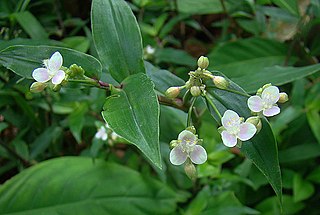
Tripogandra is a genus of flowering plants in the spiderwort family, Commelinaceae. It is native to the Western Hemisphere from central Mexico and the West Indies south to Argentina.
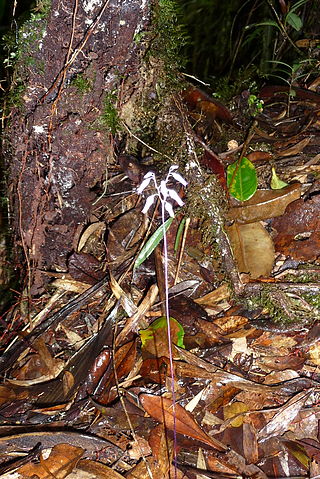
Dictyostega is a genus of flowering plants in the Burmanniaceae, first described as a genus in 1840. It contains only one known species, Dictyostega orobanchoides, native to southern Mexico, Central America, Trinidad, and South America ).

Odontadenia is a genus of plant in the family Apocynaceae, first described as a genus in 1841. It is native to southern Mexico, Central America, South America, and the West Indies.
- Odontadenia anomala(Van Heurck & Müll.Arg.) J.F.Macbr. - Peru, Bolivia
- Odontadenia campanulataJ.F.Morales - Colombia
- Odontadenia funigeraWoodson - Venezuela, Colombia, Ecuador, Peru, Brazil
- Odontadenia geminata(Hoffmanns. ex Roem. & Schult.) Müll.Arg. - 3 Guianas, Venezuela, Colombia, Ecuador, Peru, Bolivia, N Brazil
- Odontadenia glaucaWoodson - Amazonas State in S Venezuela
- Odontadenia gracilipes(Stadelm.) Woodson - Minas Gerais
- Odontadenia hypoglauca(Stadelm.) Müll.Arg. - Bolivia, Brazil
- Odontadenia killipiiWoodson - French Guiana, Venezuela, Colombia, Ecuador, Peru, N Brazil
- Odontadenia kochiiPilg. - Guyana, Venezuela, Colombia, Ecuador, Peru, N Brazil
- Odontadenia laxiflora(Rusby) Woodson - Peru, Bolivia, N Brazil
- Odontadenia lutea(Vell.) Markgr. - Peru, Bolivia, Brazil
- Odontadenia macrantha(Roem. & Schult.) Markgr. - Oaxaca, Chiapas, Central America, Trinidad & Tobago, 3 Guianas, Venezuela, Colombia, Ecuador, Peru, Brazil
- Odontadenia markgrafianaJ.F.Morales - French Guiana, N Brazil
- Odontadenia matogrossanaJ.F.Morales - Goiás, Mato Grosso
- Odontadenia nitida(Vahl) Müll.Arg. - Trinidad & Tobago, 3 Guianas, Venezuela, Colombia, Ecuador, Peru, Brazil, Bolivia
- Odontadenia perrottetii(A.DC.) Woodson - Venezuela, Colombia, Brazil, Bolivia, Guyana, French Guiana
- Odontadenia polyneura(Urb.) Woodson - Hispaniola
- Odontadenia puncticulosa(Rich.) Pulle - Central America, 3 Guianas, Venezuela, Colombia, Ecuador, Peru, Brazil, Bolivia
- Odontadenia stemmadeniifoliaWoodson - Venezuela, Colombia, Ecuador, Peru, Brazil
- Odontadenia verrucosa(Willd. ex Roem. & Schult.) K.Schum. ex Markgr. - 3 Guianas, Venezuela, Colombia, Ecuador, Peru, Brazil, Bolivia, Panama, Costa Rica, Nicaragua
- Odontadenia cuspidataRusby = Mandevilla cuspidata(Rusby) Woodson
- Odontadenia duckeiMarkgr. = Mandevilla pohliana(Stadelm.) A.H.Gentry
- Odontadenia glandulosa(Ruiz & Pav.) K.Schum. = Mandevilla glandulosa(Ruiz & Pav.) Woodson
- Odontadenia macrocalyx(Müll.Arg.) Miers = Tabernaemontana macrocalyxMüll.Arg.
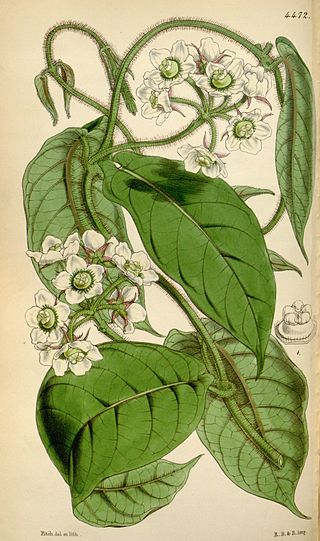
Fischeria is a plant genus in the family Apocynaceae, first described as a genus in 1813. It is native to South America, Central America, southern Mexico, and the West Indies.
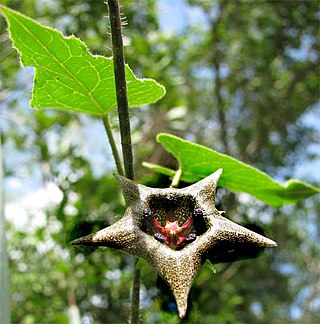
Dictyanthus is a genus of plant in family Apocynaceae, first described as a genus in 1844. It is native to Mexico and Central America.


















